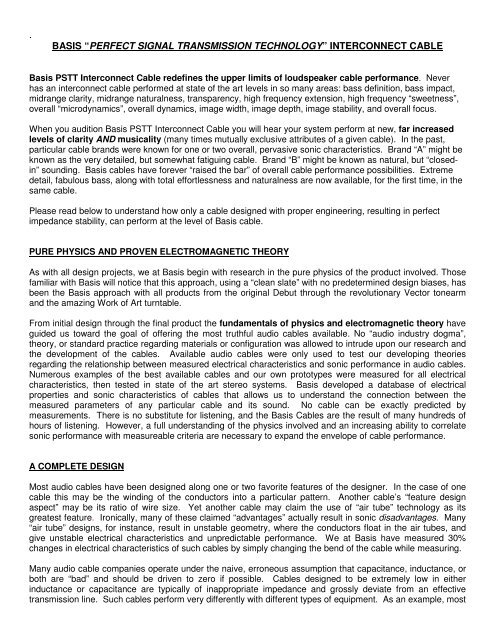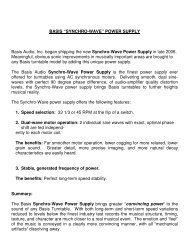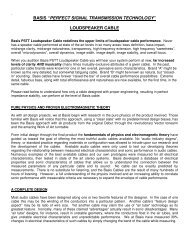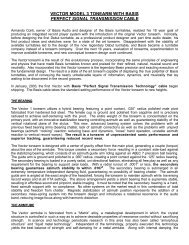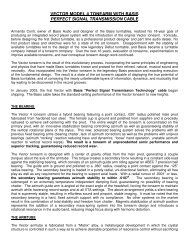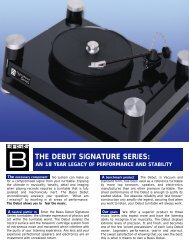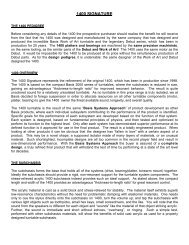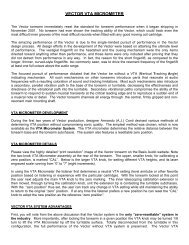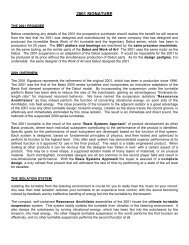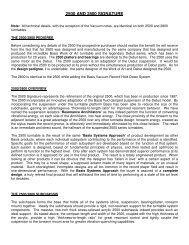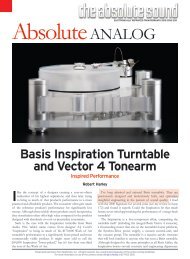Download PDF File - Basis Audio
Download PDF File - Basis Audio
Download PDF File - Basis Audio
You also want an ePaper? Increase the reach of your titles
YUMPU automatically turns print PDFs into web optimized ePapers that Google loves.
.BASIS “PERFECT SIGNAL TRANSMISSION TECHNOLOGY” INTERCONNECT CABLE<strong>Basis</strong> PSTT Interconnect Cable redefines the upper limits of loudspeaker cable performance. Neverhas an interconnect cable performed at state of the art levels in so many areas: bass definition, bass impact,midrange clarity, midrange naturalness, transparency, high frequency extension, high frequency “sweetness”,overall “microdynamics”, overall dynamics, image width, image depth, image stability, and overall focus.When you audition <strong>Basis</strong> PSTT Interconnect Cable you will hear your system perform at new, far increasedlevels of clarity AND musicality (many times mutually exclusive attributes of a given cable). In the past,particular cable brands were known for one or two overall, pervasive sonic characteristics. Brand “A” might beknown as the very detailed, but somewhat fatiguing cable. Brand “B” might be known as natural, but “closedin”sounding. <strong>Basis</strong> cables have forever “raised the bar” of overall cable performance possibilities. Extremedetail, fabulous bass, along with total effortlessness and naturalness are now available, for the first time, in thesame cable.Please read below to understand how only a cable designed with proper engineering, resulting in perfectimpedance stability, can perform at the level of <strong>Basis</strong> cable.PURE PHYSICS AND PROVEN ELECTROMAGNETIC THEORYAs with all design projects, we at <strong>Basis</strong> begin with research in the pure physics of the product involved. Thosefamiliar with <strong>Basis</strong> will notice that this approach, using a “clean slate” with no predetermined design biases, hasbeen the <strong>Basis</strong> approach with all products from the original Debut through the revolutionary Vector tonearmand the amazing Work of Art turntable.From initial design through the final product the fundamentals of physics and electromagnetic theory haveguided us toward the goal of offering the most truthful audio cables available. No “audio industry dogma”,theory, or standard practice regarding materials or configuration was allowed to intrude upon our research andthe development of the cables. Available audio cables were only used to test our developing theoriesregarding the relationship between measured electrical characteristics and sonic performance in audio cables.Numerous examples of the best available cables and our own prototypes were measured for all electricalcharacteristics, then tested in state of the art stereo systems. <strong>Basis</strong> developed a database of electricalproperties and sonic characteristics of cables that allows us to understand the connection between themeasured parameters of any particular cable and its sound. No cable can be exactly predicted bymeasurements. There is no substitute for listening, and the <strong>Basis</strong> Cables are the result of many hundreds ofhours of listening. However, a full understanding of the physics involved and an increasing ability to correlatesonic performance with measureable criteria are necessary to expand the envelope of cable performance.A COMPLETE DESIGNMost audio cables have been designed along one or two favorite features of the designer. In the case of onecable this may be the winding of the conductors into a particular pattern. Another cable’s “feature designaspect” may be its ratio of wire size. Yet another cable may claim the use of “air tube” technology as itsgreatest feature. Ironically, many of these claimed “advantages” actually result in sonic disadvantages. Many“air tube” designs, for instance, result in unstable geometry, where the conductors float in the air tubes, andgive unstable electrical characteristics and unpredictable performance. We at <strong>Basis</strong> have measured 30%changes in electrical characteristics of such cables by simply changing the bend of the cable while measuring.Many audio cable companies operate under the naive, erroneous assumption that capacitance, inductance, orboth are “bad” and should be driven to zero if possible. Cables designed to be extremely low in eitherinductance or capacitance are typically of inappropriate impedance and grossly deviate from an effectivetransmission line. Such cables perform very differently with different types of equipment. As an example, most
audiophiles are familiar with the flat, ribbon cables made by some companies. Flat cables typically result inunusual values of capacitance and impedance, which is why some such cables are actually unstable withparticular electronics, even requiring discrete loading components to achieve stability. <strong>Basis</strong> cables, reflectingtheir “distortionless transmission line” design, are totally stable with all loads.Fixating on one design aspect, as in the above examples, may make for “catchy” marketing, but invariablyresults in incomplete cable designs.We at <strong>Basis</strong> understand that all aspects of an audio cable are critical. A complete design must account formany factors and not overlook any. <strong>Basis</strong> specifies such extreme requirements of materials and processes, allof which are necessary to achieve our performance and stability goals, that we have found only two hightech/militarycable specialist manufacturers in the USA who are capable of manufacturing <strong>Basis</strong> Signal Cables.<strong>Basis</strong> PSTT Interconnect Cable effectively addresses all pertinent material and electrical properties,including:1. Conductor material: The highest purity proprietary copper alloy is used throughout all cables.2. Dielectric material: The most pure form of the world’s finest dielectric is used, un-dyed for all primary andsecondary insulation needs as well as cable cores.3. Skin Effect design: <strong>Basis</strong> has defined interconnect cable effective cross-sectional area and cablegeometry to eliminate skin effect concerns, even at multiples of the highest audio frequencies, producingsuperior imaging, impact, reverberation, and tonality.4. Impedance matching: Through innovative use of materials and geometry <strong>Basis</strong> has succeeded in bringingthe impedance to match the connectors used, preventing reflections at the connector/cable interface.Phono-stage and line-level signals are therefore transferred without distortion-producing reflections ateither source or load end.5. Extreme, exotic-material double shielding: Transmitting the signal perfectly is a formidable challenge.However, shielding and protecting small phono-stage level and line-level signals from outside noise is justas important, though commonly overlooked. Most cables are shielded, to some degree, from highfrequencynoise. None are effectively shielded from the always-present power-line frequency magneticfields. Interconnects are typically in close proximity to power cords, component transformers, andhousehold wiring. All are strong sources of low-frequency magnetic field noise. <strong>Basis</strong> Interconnects aredouble shielded, including a shield of exotic high-permeability material to eliminate RFI and magnetic noisefrom distorting your audio signal. <strong>Basis</strong> cables therefore deliver lower hum levels, lower noise levels,greater background “blackness”, higher transparency, and more low-level detail. Your amplifier will delivermore power to your speakers and exhibit lower intermodulation distortion as it is freed from amplifying nonmusicalnoise, especially power robbing low frequency noise. Your loudspeakers will also be morecoherent and lower in distortion when not reproducing this non-audio content.6. “Distortionless Transmission Line” performance: Electrical characteristics are balanced in the single,unique condition to meet “distortionless transmission line” conditions. This balance of conditions, dictatedby proven physics, is the only avenue to attain constant phase across a wide frequency range.A constant perfect phase relationship between all frequencies produces results not attainable if thiscondition is not met. Foremost in the sound of a “distortionless transmission line” may be a “naturalcoherence” that can be “felt” on an instinctive level by the listener. The individual sonic properties thatmany audiophiles analyze, such as attack, decay, tonality, and soundfield echoes so convincingly “play offof each other” and combine as to make analytical listening almost superfluous. So involving is the musicthat analytical listening is actually much more difficult to perform in a system with <strong>Basis</strong> signal cables fromsource through speakers. To explain just how natural this effect of correct phase is please contemplatethis analogy. Imagine sitting in the middle of a totally dark room with a person speaking behind and to theleft of you. In a few moments you would be able to locate this person. Your mind automatically would
analyze the slight difference in the arrival of the sound between your left and right ears. Your mind wouldanalyze the echoes to further locate the speaker as well as to determine the size of the room. None of thisprocess is conscious or subject to logical analysis. In a similar manner, when you first listen to <strong>Basis</strong> signalcables you will perceive a “rightness” which will transcend analysis……you will not need to analyze thesound. However, when you force yourself to analyze the sound you will find that the “mental checklist” youhave learned to make while evaluating audio equipment, with factors such as stage width, stage depth,natural decay, attack, quality of soundfield echoes, resolution, transparency, will be fully satisfied.WIDE SYSTEM COMPATIBILITYThe favorable impedance of the <strong>Basis</strong> Interconnect Cable (see item 4, above) combined with distortionlesstransmission line characteristics (see item 6, above) mean a cable which has neutral sonic characteristics andperfect phase performance when used with a wide variety of components. The <strong>Basis</strong> Interconnect Cablesare as “at home” with OTL (output transformerless tube amplifiers) as high-powered solid-stateamplifiers. Whether you use single-ended transformer-coupled tube amplifiers, push-pull tube amplifiers,solid-state amplifiers, tube or solid state phone stages and preamps, you will receive the same performancefrom your <strong>Basis</strong> Interconnect Cables.ADDITIONAL TECHNICAL DETAILSFor further technical discussion of the electrical characteristics of cables (impedance, inductance, capacitance,resistance, leakage, and the frequency dependence of inductance, capacitance, and impedance), and howthese characteristics determine the sound of cables, please watch the <strong>Basis</strong> Website (www.basisaudio.com).In the near future <strong>Basis</strong> will provide a technical paper defining these parameters and their relationships. Youmay also e-mail <strong>Basis</strong> at any time regarding the availability of this paper.


